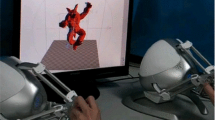Abstract
Simulating deformable objects based on physical laws has become the most popular technique for modeling textiles, skin, or volumetric soft objects like human tissue. The physical model leads to an ordinary differential equation. Recently, several approaches to fast algorithms have been proposed.
In this work, more profound numerical background about numerical stiffness is provided. Stiff equations impose stability restrictions on a numerical integrator. Some one-step and multistep methods with adequate stability properties are presented. For an efficient implementation, the inexact Newton method is discussed. Applications to 2D and 3D elasticity problems show that the discussed methods are faster and give higher-quality solutions than the commonly used linearized Euler method.
Similar content being viewed by others
References
Atanackovic TM, Guran A (2000) Theory of elasticity for scientists and engineers. Birkhäuser, Boston
Baraff D, Witkin A (1998) Large steps in cloth simulation. In: Cohen M (ed) Proceedings of SIGGRAPH ’98, Orlando, FL, July 1998, pp 43–54. ACM SIGGRAPH, Addison-Wesley, Reading, MA
Bathe KL (1982) Finite element methods. Prentice-Hall, Englewood Cliffs, NJ
Breen DE, House DH, Wozny MJ (1994) Predicting the drape of woven cloth using interacting particles. In: Glassner A (ed) Proceedings of SIGGRAPH ’94, Orlando, FL, July 1994, pp 365–372. ACM SIGGRAPH, ACM Press, New York
Debunne G, Desbrun M, Barr A, Cani M-P (1999) Interactive multiresolution animation of deformable models. In: Magnenat-Thalmann N, Thalmann D (eds) Proceedings of Computer Animation and Simulation ’99, Milan, September 1999, pp 133–144. Springer, Berlin Heidelberg New York
Debunne G, Desbrun M, Cani M-P, Barr AH (2001) Dynamic real-time deformations using space and time adaptive sampling. In: Proceedings of SIGGRAPH ’01, Computer Graphics, Los Angeles, August 2001, pp 31–36
Desbrun M, Schröder P, Barr A (1999) Interactive animation of structured deformable objects. In: Proceedings of Graphics Interface 99, Kingston, ON, Canada, June 1999, pp 1–8
Eberhardt B, Weber A, Strasser W (1996) A fast, flexible, particle-system model for cloth draping. IEEE Comput Graph Appl 16(5):52–60
Eberhardt B, Etzmuss O, Hauth M (2000) Implicit-explicit schemes for fast animation with particle systems. In: Proceedings of the Eurographics computer animation and simulation workshop, Interlaken, Switzerland, August 2000, pp 137–151
Etzmuss O, Gross J, Strasser W (2001) Deriving a particle system from continuum mechanics. Trans Vis Comput Graph (in press)
Freund RW, Hochbruck M (1994) On the use of two QMR algorithms for solving singular systems and applications in Markov chain modeling. Numer Linear Algebra Appl 1(4):403–420
Hairer E, Wanner G (1996) Solving ordinary differential equations II, 2nd edn. Springer, Berlin Heidelberg New York, Berlin
Hairer E, Wanner G (1999) Stiff differential equations solved by Radau methods. J Comput Appl Math 111(1–2):93–111
Hauth M, Etzmuss O (2001) A high performance solver for the animation of deformable objects using advanced numerical methods. In: Proceedings of Eurographics, Manchester, UK, September 2001, pp 137–151
House DH, Breen DE (eds) (2000) Cloth modeling and animation. AK Peters, Natick, MA
James DL, Pai DK (1999) ArtDefo – accurate real time deformable objects. In: Proceedings of SIGGRAPH ’99, Computer Graphics, Los Angeles, August 1999, pp 65–72. ACM SIGGRAPH, ACM Press, New York
Kang Y-M, Choi J-H, Cho H-G, Lee D-H, Park C-J. Real-time animation technique for flexible and thin objects. In: Proceedings of WSCG 2000, Pilsen, Czech Republic, February 2000, pp 322–329
Lin M, Gottschalk S (1998) Collision detection between geometric models: a survey. In: Proceedings of the IMA conference on mathematics of surfaces, Winchester, UK, September 1998, pp 37–56
Mezger J, Kimmerle S, Etzmuss O (2002) Improved collision detection and response techniques for cloth animation. Technical Report WSI-2002-5, Universität Tübingen, Tübingen, Germany
O’Brien JF, Hodgins JK (1999) Graphical modeling and animation of brittle. In: Proceedings of SIGGRAPH ’99, Computer Graphics, Los Angeles, August 1999, pp 137–146. Addison Wesley Longman, Reading, MA
Picinbono G, Delingette H, Ayache N (2001) Non-linear anisotropic elasticity for real-time surgery simulation. In: Proceedings of the IEEE International Conference Robotics and Automation 2001, Seoul, South Korea, May 2001
Platt JC, Barr AH (1988) Constraint methods for flexible models. In: Dill J (ed) Proceedings of SIGGRAPH ’88, Atlanta, Georgia, August 1988, pp 279–288. ACM SIGGRAPH, Addison-Wesley, Reading, MA
Press WH, Teukolski SA, Vetterling WT, Flannery BP (1988) Numerical recipes in C: the art of scientific computing, 1st edn. Cambridge University Press, Cambridge, UK
Provot X (1995) Deformation constraints in a mass-spring model to describe rigid cloth behavior. In: Davis WA, Prusinkiewicz P (eds) Proceedings of Graphics Interface ’95, Quebec, May 1995, pp 147–154
Rheinboldt WC (1998) Methods for solving systems of nonlinear equations. In: CBMS-NSF regional conference series in applied mathematics, vol 70, 2nd edn. SIAM
Saad Y (1996) Iterative methods for sparse linear systems. PWS, Boston
Terzopoulos D, Fleischer K (1988) Deformable models. Vis Comput 4:306–331
Volino P, Magnenat-Thalmann N (1994) Efficient self-collision detection on smoothly discretized surface animations using geometrical shape regularity. In: Computer Graphics Forum (Eurographics’94 Conference Issue) 13(3):155–166
Volino P, Magnenat-Thalmann N (2000a) Accurate collision response on polygonal meshes. In: Proceedings of the Computer Animation Conference, Philadelphia, May 2000, pp 154—163. IEEE Press New York
Volino P, Magnenat-Thalmann N (2000b) Implementing fast cloth simulation with collision response. In: Proceedings of Computer Graphics International (CGI’00), Geneva, Switzerland, June 2000, pp 257–268. IEEE Press, New York
Volino P, Magnenat-Thalmann N (2001) Comparing efficiency of integration methods for cloth animation. In: Proceedings of Computer Graphics International (CGI’01), Hong Kong, July 2001, pp 265–274. IEEE Press, New York
Author information
Authors and Affiliations
Corresponding author
Rights and permissions
About this article
Cite this article
Hauth, M., Etzmuss, O. & Strasser, W. Analysis of numerical methods for the simulation of deformable models. Vis Comput 19, 581–600 (2003). https://doi.org/10.1007/s00371-003-0206-2
Published:
Issue Date:
DOI: https://doi.org/10.1007/s00371-003-0206-2



